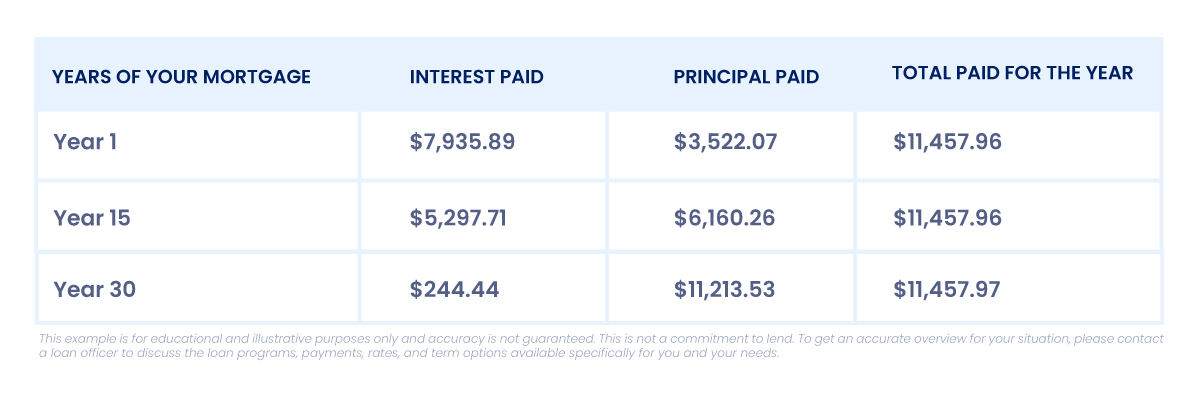
Understanding What’s in Your Mortgage Payment
Whether you’re daydreaming about the dream home or are in the middle of house-hunting for it—it’s important to have a strong grasp on how the monthly mortgage payment factors into your situation.
And the absolute first step of that is understanding what is included in a mortgage payment. We’ll break it down and explain each component one at a time.
Principal Payment
The principal is the amount of money you borrow to cover the cost of the home you are buying. An easy way to think of principal is that it’s the home’s final selling price minus the down payment.
Principal = [Home’s Selling Price] – [Down Payment]
As the largest variable in your home-financing calculation, the principal is the most important factor in determining how much home you can afford. It’s critical to understand how the other variables both influence and are influenced by your principal amount—you can use our mortgage calculator to gain a better sense of what we mean.
Pro Tip: Loan terms can usually be shortened by paying more than the minimum loan payment each month. You’ll need to indicate that the additional funds should be applied to pay down the principal loan balance.
Interest Payment
The other important component of your monthly mortgage payment is interest.
Interest is the money you pay to your mortgage lender in exchange for providing you with their lending services.
So, while principal and interest are the two elements to your mortgage that you’re paying off over time, principal is dependent on the cost of the home—whereas interest rates are more dependent on economic factors and investment activity (such as the secondary market).
How are These Two Calculated?
Our mortgage calculator can give you a much better idea of how principal and interest are calculated—but since we’re here—let’s take a look at a practical example for educational purposes. Consider the following hypothetical scenario:
- Let’s say your mortgage is a simple 30-year, fixed-rate mortgage of $200,000.
- With an interest rate of 4% and no late payments or prepayments.
Based on the above example, your monthly mortgage payment would be $954.83.
To go one level deeper—part of your monthly payment will go towards interest, and the rest goes towards your principal. The important thing to note is that with each payment, more of your money is going towards your principal and less towards interest. To visualize this easily:

Paying off your mortgage is a lot like a snowball rolling down a hill!
Other Components
While principal and interest are the two primary components of monthly mortgage payments, there are other factors ultimately in the mix. It pays to also consider the following when thinking about the money needed for the house you’re financing:
Taxes
In terms of homebuying, you’ll be paying property taxes. Property taxes are a percentage of your property’s value, which can change from year to year.
One thing to be aware of is that your property tax is based on local tax rates as well as your property’s assessed value, which is not necessarily always the same thing as the market value.
Market Value is how much a house would sell for under normal conditions—excluding “what-if” scenarios like when a buyer or seller is under pressure to act due to life events. Market value is basically a generalized, well-educated guess.
Assessed Value is the value that comes about for the sake of calculating the appropriate tax rates. An assessment will typically consider things like sales of similar homes in the area and home inspection findings.
While they’re often closely linked, one can theoretically change without the other!
Insurance
Homeowner’s Insurance is the money you’ll pay to insure the house against any kind of environmental disaster or accident on your property. If—knock on wood—something were to happen that damaged the house, your homeowner’s insurance will typically cover the cost of repairs to return your property’s value back to where it was before it was damaged.
Private Mortgage Insurance (PMI) is the money you’ll pay to insure the loan when a down payment is less than 20 percent. This insurance protects the lender from the off-chance that you’re unable to repay your loan.
Note that mortgage insurance may be paid as an add-on to a monthly mortgage payment, paid upfront, or at closing. The amount required is determined based on your loan program type, property type, credit score, and the ratio of the loan value to the value of the property being purchased.
Homeowners Association Fees
Depending on your neighborhood, you may also have Homeowners Association (HOA) fees to keep in mind. HOA fees go towards maintaining shared properties, facilities, or services of a collective residential community. The next time you’re enjoying the neighborhood pool or tennis courts, give yourself (and your HOA) a pat on the back for helping make it happen!
Escrow
In some instances, your lender may be required to hold a reserve of your monthly payments to cover any additional costs like private mortgage insurance or property taxes—this is called escrow.
Escrow is like a mandatory savings account tied to your home loan payment. An escrow account will hold the money needed for property taxes, insurance, and other items until these are required to be paid. The amount paid to escrow may fluctuate over the life of the loan based on changes to property taxes and homeowner insurance.
Other Good-to-Know Info
With the primary and secondary factors all spelled out, you’d think we’d be tapped out of useful information to share. Surprise! We’ve got two more handy pro-tips related to your mortgage payment that you’re going to want to know.
Making Extra Payments
We touched on this when covering your principal payments up above, but it’s so important it’s worth repeating—you can make extra payments on your mortgage.
The big benefit of making extra payments is that if applied to the principal it will shorten the life of your loan, which may also reduce the total interest amount paid. The end result is that you could pay off your mortgage early and potentially save thousands of dollars in the long run!
Removing PMI
Private Mortgage Insurance (PMI) is often required when the down payment is less than 20%. However, when you achieve a loan-to-value (LTV) ratio of 80% or less (i.e. when you have 20% equity in your home), PMI is typically no longer required.
NOTE: by law, PMI is removed once your LTV reaches 78% of the original payment schedule at closing.
One good rule of thumb is to check with your lender as soon as you hit 80% LTV (i.e. when you have 20% equity in your home) and see if you can have your PMI removed. It might be only a 2% difference on paper, but every dollar counts! No need to pay for something if it’s not necessary.
Your Next Steps
Now that you’re well-equipped to understand what is included in a mortgage payment, it makes sense to start mapping out what your homebuying journey might look like—you know, everything that ultimately comes before the mortgage payment. A great next step is to see if you can get pre-approved—a preapproval can give you insight into your loan term options, credit score, and how much you can afford to finance.
For that, you’ll need a trusted mortgage originator you can count and rely on and that’s where we’re able to help. With over 11,000 5-star reviews from happy clients, we pride ourselves on our exceptional client service committed to delivering a fast, efficient, and hassle-free experience. Between that and our great rates with complete offerings of Conventional, FHA, VA, Jumbo, and USDA Loan products, we’re all set to help take you from “what’s next?” to “welcome home.” Reach out today!









